iCERi 2010
International Conference of Education, Research and Innovation.
Lo spirito divulgativo che anima le pagine di questo blog trova espressione nella pubblicazione di risultati e lavori scientifici che interessano l'universo digitale e l'architettura. Ho ritenuto così opportuno pubblicare anche in questa sede il testo integrale della presentazione che ho tenuto il 15 novembre scorso a Madrid, in occasione di iCERi 2010 - International Conference of Education, Research and Innovation.
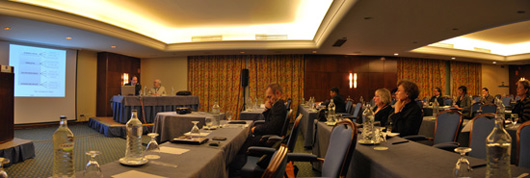
La conferenza, che verteva sui metodi e le tecnologie rivolte alla conoscenza, all'insegnamento ed alla divulgazione del sapere è stata occasione per presentare ad un pubblico più vasto la mia teoria delle "Scatole cinesi", secondo la quale tutti i modelli digitali di astrazione usati in ingegneria ed architettura dovrebbero convergere in un unico archivio centralizzato, ricorsivamente ampliato nei contenuti via via che il progetto si sviluppa, secondo logiche auto-similari. Mi auguro che questo contributo possa trovare l'interesse di chi mi leggerà.
Simone Garagnani
UNPACKING THE “CHINESE BOX”:
MANAGING KNOWLEDGE IN ARCHITECTURAL DIGITAL MODELS
Thanks to the chair for the introduction and many thanks to all of you: all my appreciation for surviving such a long conference day.
The so called “digital revolution” has amplified the perception of time and space gained from relativistic physics, suggesting new “virtual realities”. It’s the idea of Cyberspace, an ephemeral no-place where it’s possible to build digital architectures, conceived as a multitude of contents formally interrelated. Undergraduate students approaching new media have to deal with this first of others, taking advantage of tools useful to explain spaces and places. Mastering these instruments as future practitioners, they will be able to describe their projects avoiding overlaps and inconsistencies.
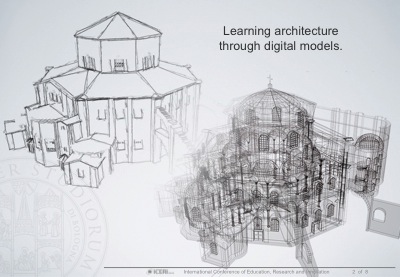
In fact, design process as taught in contemporary Schools of Architecture or Engineering is divided into conceptual approach, real fabrication, and maintenance of buildings; it’s very important for students to learn this sequence, since they have to deeply analyze each aspect expanding their skills in multi-disciplinary ways. However, contemporary technology which turns edificés into well organized digital archives, is still not deep-rooted in designer’s culture, since this approach seems to be costly in terms of commitment and cause of errors and omissions. This speech will focus on a proposed method to teach students how to make the most of information technology techniques, in order to collect data about architectural environments, favouring their learning experience through a complex digital framework called “Chinese box”.
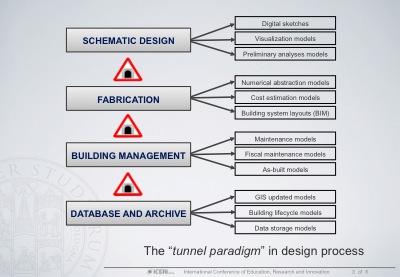
The building process could be interpreted as a not completely recursive top-down algorithm, in which the information included in every stage is continuously modified, from conceptual abstraction to a completely different built project, deeply transformed during its evolution. To use a metaphor, it would be like all models in development stages would enter into tunnels during which they were subject to mutations completely unrelated to previous or following steps. Getting out of each tunnel, digital models appear deeply amended if compared to their previous state: they are ready to take the next tunnel, getting a further development which will embed again different abstractions into them while they should be emanations of the original idea instead. Analyzing a real building through surveys or formalizing new architectural projects, students run into several “tunnels” too, since they have to use various tools for each step of their increasing awareness about project. The outlined scenario, the tunnel metaphor, reveals how critical is to manage information all over the design process, even in real fabrication world. On the contrary, an integrated model structured to collect documents proper of every stage, should limit this loss of information through passages, overcoming tunnel’s impediments and sharing cognitive séquences as they really are.
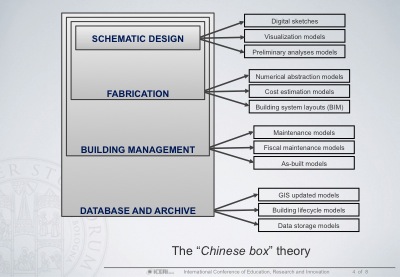
The “Chinese box” paradigm, as intended in this work, is first of all a recursive criterion destined to increase the information level enclosed into an undivided, lossless, digital computer model. A “Chinese box” is a multi-discipline cognitive catalogue which establishes an ordering principle for complexity in a formalization of hierarchical classes, embedding drawings, pictures, calculations and analytical schemes into a global archive. This approach was influenced by Lindenmayer works on relationships present in plants morphology, since the main structure is completed step by step while growing. Digital models realized to investigate Basilica of San Vitale for example, a following described case study, recursively followed this process stacking up subsequent data acquisition during three distinct phases: synthesis, reduction and projection. Synthesis is expression of how information can be collected and ideally formalized into computer models, where geometry can be reconstructed for homology in virtual space, gathering heterogeneous data including pictures, sketches, or tables from surveys: it’s the modelling step. Reduction is mainly an oversimplification of the geometric and cognitive model produced, in order to control it in computer memory during analytical calculations. It’s a sort of abstraction aimed to define levels of detail. Finally, with the projection, the informative model is presented to final users onto different devices, through the medium of technical drawings, visual renderings, performance charts overlapped to digital geometry and so forth. This is, briefly, the presentation of final results.
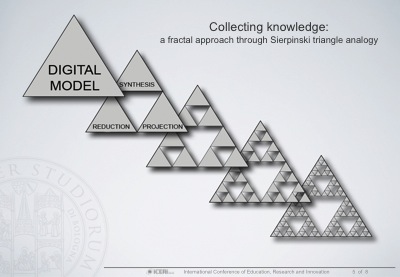
These steps are cyclically performed so that a richer model ease several uses since it includes materials for a wide number of possible abstractions. Even changing the level of detail however, what has been previously acquired remains the same, with knowledge gradually enclosed in different boxes, one inside the other but similar in structure. The three-staged scheme recalls the Sierpinski’s triangle, a fractal result of figures recursively repeated. Beginning from conceptual modelling, every time a significant development in synthesis, reduction or projection is achieved, a progressive complication is added.
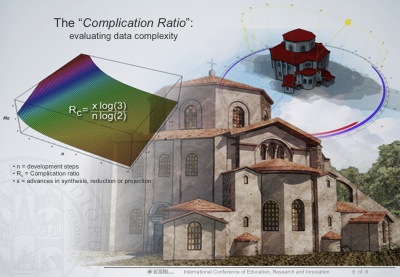
In this way the “Chinese box” model evolves, relating its changing to a constant value similar to the formulation by Hausdorff for Sierpinski’s triangle fractal dimension, expressed in a specific format called Complication Ratio. A descending Complication Ratio indicates therefore an increasing level of development allowing extensive possibilities; it decreases quickly in the early stages of integration and becomes stable later, tending to a gradual asymptotic limit.
The “Chinese box” theory was applied in my Ph.D. research on a well-known example of monumental architecture, chosen to test the experimental chain using different computer programs to document various aspects. The monument elected was San Vitale, an Italian church in Ravenna and one of the most important examples of early Christian Byzantine architecture in Western Europe. A geometrical survey was realized together with natural lighting simulations inside the church, carried out through several investigation steps. The increasing knowledge about San Vitale has been embedded into a 3D model, gradually changing its content through synthesis, reduction and projection as well, with lower and lower Rc values according to the analytical law identified. Presentation of final achievements to students, teaching them how to combine used tools to express and structure their work on similar themes, constituted the most interesting aspect from the pedagogic point of view in addition to the clearest expression of what a “Chinese box” is.
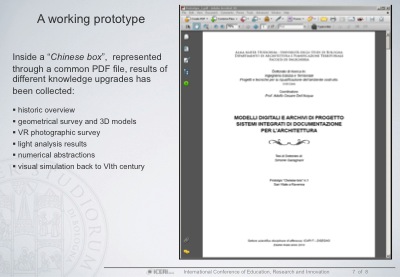
Exploring a simplified 3D model it’s possible to focus attention on details which can be delved linking results obtained from previous steps. Students can integrate information as they wish or browse analytical result from the same database increasing the level of detail as needed.
The “Chinese box” modelling is not a computer program, it’s a human activity which involves an inevitable process of change in methods applied to architectural-related disciplines. A survey conducted in 2007 showed how the 74% of the architectural firms in the United States for example, are already using integrated modelling technology but only 34% of them use it properly; this is due to lack of well prepared new professional figures capable of handling interoperable software. So training students for this challenge is surely a valuable curriculum attainment, which promotes the “Chinese box” knowledge management as an alternative to traditional technical design documentation, as it can’t successfully integrate all the cognitive work flows in a unique, coherent manner.
Thank you very much for your attention.
Nessun commento
Info
Dal 2004 questo piccolo angolo di rete raccoglie gli interessi di ricerca e i lavori di sperimentazione digitale di Simone Garagnani in materia di cultura geek, ma soprattutto di Building Information Modeling, rilievi digitali ad alta risoluzione e computer graphics legata al mondo dell'architettura, dell'ingegneria e delle costruzioni. TC Project, è presente anche sul social network Facebook.
Welcome to these pages that host since 2004 Simone Garagnani's personal blog, a collection of nerd notes and geek experiences focused sometimes on Building Information Modeling, terrestrial laser scanning, digital photogrammetry and computer graphics applied to the AEC world. The TC Project is also available on Facebook.
Segui le attività in TC Project: Registrazione
Follow TC Project activities: Registration/login
Ultimi commenti
Trevor Dwyer (VIC-20 The friend…): Hi there, I feel your pain on updates and the internet not being the same these days – well since 199…SiliconSimon (Cray-1 - The home…): If someone is interested in my little Cray’s files, please PM me since I do not often read comments o…
SiliconSimon (Cray-1 - The home…): Of course Mike, I sent you a PM!
Robert (Cray-1 - The home…): If it’s possible, I would love to get the files from you for this project. I have a Cray-1 chip sitti…
Mike (Cray-1 - The home…): Are the files still available?
MojaMonkey (SGI VW540 @ TC La…): Hi Simon? This is a long shot but I was wondering if you have a copy of the SGI drivers required to…






